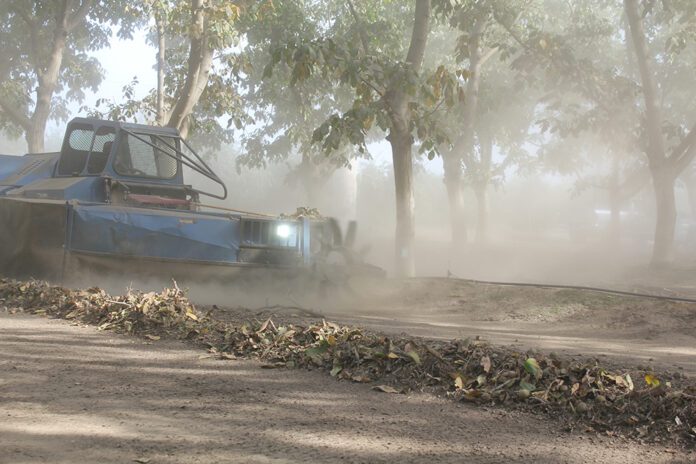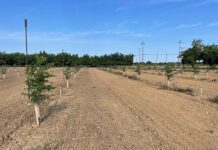
Of all the challenges facing California walnut growers, market uncertainty may be the toughest to overcome. A record-size 2023 crop, below break-even prices for growers and higher input costs are placing many walnut growers in precarious financial positions.
Pricing is forecast to be under pressure until tonnage approaches an estimated 625,000 tons.
At the 52nd annual Tri-County Walnut Day in Tulare, it was noted “some growers are out of business, but they just don’t know it yet.”
As of September 2023, California Walnut Board, via a Land IQ acreage survey, showed an estimate of 375,578 producing walnut acres. Non-bearing acreage estimate totaled 35,206. An estimated 6,590 acres were listed stressed or abandoned.
Low returns for walnuts in recent years has sparked record numbers of orchard removals. The Land IQ survey showed from October 2022 to August 2023, 28,910 acres were removed from production.
Bob Beede, UCCE farm advisor emeritus, said few if any of the pulled orchard sites are being replanted with walnuts. Other crops, notably pistachios, were being considered as replacements, but there is concern the acreage limit has been reached on this nut as well.
Beede noted more walnuts were coming out of the ground in the south San Joaquin Valley than the north. The south still has Serr and Vina, which have fallen out of industry favor due to insufficient light meats. Recent years of drought, high summer temperatures and inadequate winter chill have also contributed to young orchard removals.
While walnut growers may decide to keep farming and hope the prices they receive for their crop improve, Beede pointed out several considerations: The cost to farm walnuts is estimated at $2,600 to $3,000 an acre; water availability and cost; adequate winter chill; the effect of hot temperatures on walnut quality; and the condition of growers’ farm equipment, irrigation wells and orchards.
Questions remain about the possibility of government assistance and the time it will take before walnut prices climb back to at least 90 cents. At 6,000 pounds per acre, 45 to 50 cents a pound is about break-even, Beede said.
Crop Removal an Option
One option proposed for walnut growers to save production and harvest expense is to remove the crop with a plant growth regulator (PGR). Removal could save water and nutrient costs, eliminate pesticide and fungicide applications and cut out harvest and hauling costs.
Beede said walnut flower and fruit removal experiments were done in 1985-88 by UCCE farm advisor Bill Coates in San Benito County and UC Davis Pomology Professor George Martin. The trials were conducted in the Hollister area on three- to four-year-old Pedro and Howard trees. Flower removal was intended to reduce early Cherry Leafroll virus (Blackline) infection sites near the graft union. Reduction in early fruit set on the highly precocious new cultivars like Ivanhoe was also intended to solve the early stunting problem by providing more photosynthates to the shoots.
The PGRs tested were NAA (Auxin) gibberellic acid and ethephon (Ethrel). Timings tested were full bloom up to 3.5 weeks post full bloom. Only ethephon justified further evaluation.
In 1986, Coates and Martin reported newly set nut removal with ethephon was 100% at both 2 and 4 pt./100 gallons water, but tree growth was inhibited more at the higher rate. There was also some phytotoxicity reported. Their report stated the 4-pint rate caused excessive foliar phytotoxicity, but 2 pints resulted in only slight to moderate foliar injury.
In 1988, ethephon applied to young Howard trees at 1 pt./100 gallons water one week after full bloom resulted in only 79% nut removal with slight phytotoxicity and reduction in growth. Treating three weeks after full bloom resulted in 100% nut removal with similar phytotoxicity and reduction in growth to the early treatment. The reduction in shoot growth from ethephon conflicted with their objective of achieving improved vigor from crop removal, so further testing was discontinued.
Beede acknowledged the experimental status of this old research, and told growers there has been no current testing by UCCE or others to determine if the rates and timings investigated by Coates and Martin on young trees produce similar results on mature trees in the Central Valley. Growers perceiving significant financial benefit from trying an estimated 2 pt./100-gallon rate might wish to consider it rather than orchard removal. Growers would assume all risk.
“Growers could legally treat newly set fruit if the current label allows application prior to the registrant’s supported use at packing tissue brown, and there is no additional restriction imposed by them,” Beede said. The fruit set application timing could be allowed by the registrant, but not supported.
Ethephon is currently registered on walnuts for application at or after packing tissue brown (PTB) to advance hull maturity and harvest date. Due to its acidity and potential for serious eye injury, it is a Category 1 material. Beede later reported the Kings County Ag Commissioner’s office supported his request to DPR for an ethephon label interpretation to determine if treatment after fruit set would be a violation of the label. DPR responded that it was not.
“Current testing on large trees and our main varieties is obviously needed to provide growers confidence that this is a viable tool to further reduce cultural costs,” Beede said. “But my conversations with growers indicate many have their backs against a financial wall that is unprecedented. They have reached the point of having to cut the trees down and leave them in place or simply abandon the orchard. This creates problems for neighbors still struggling to farm.”
Spending the money on crop inputs necessary to achieve a high-quality walnut crop is difficult to justify with the current walnut prices, Beede noted. A base price isn’t guaranteed by the processor. In the past, he said, there was a base price and then bonuses for delivering large, light-colored walnuts. Variety of nut also matters. Beede said processors will take Tulare and Chandlers, but many don’t want to handle other varieties.
Removals Expected to Continue
Robert Verloop, executive director and CEO of California Walnut Board and Commission, said walnut orchard removals are expected to continue with few new plantings in the near term. Most of those removals, he said, are older orchards with yields less than 4,500 pounds per acres. The removals are also mainly less-desirable varieties with fewer productive Chandler, Tulare and Howards being removed.
The big question he addressed in his Walnut Day presentation is if the industry has hit bottom and how long before prices move up.
Consensus is the California walnut crop needs to be 625,000 to 675,000 tons to be in balance with demand. The current production exceeds 800,000. Carryover also remains high at 141 tons. While removals are likely to continue, Beede noted at the orchard removal rate, it could take up to six years to achieve balance.
“Pricing will remain under pressure through 2024. We seem to have hit bottom, but how wide is the valley before things significantly move up?” Verloop said. He noted the 2023 walnut crop was notable for quality.
Looking at the global walnut picture, California produces 26% of the world’s walnuts down from 29% in 2017-18. China and Chile production grew with China producing 53% up from 42% and Chile producing 7% up from 5%.
California walnuts’ share of world trace dropped from 68% in 2016-17 to 44% in 2021-22. China and Chile both grew market shares. Consumption of walnuts remains flat, and the expectation of India as the next great market has not been realized.
Verloop said challenges in the global market place include the tariffs and duties on California walnuts. India removed a retaliatory tariff on California walnuts last summer, but it will take time to rebuild that market, Verloop said.
An overreliance on the assumption that demand for walnuts will always be there, a compressed California marketing window and a global walnut supply that outpaces global demand are some of the challenges facing the California walnut industry.
Processors need to shift their approach from suppliers of a commodity to partnerships and listen to consumers and customers, Verloop said.
The California product is competing with China’s high edible meat yield, and proximity to key markets. Chile’s emerging production is perceived as very light in color, larger-size nuts and high edible meat yield. In comparison, California walnuts are perceived in the world market as being smaller with lower meat yield.
“Chile has succeeded in establishing export sales and we compete with that,” Verloop said. As acreage of early harvested California walnuts shrinks due to orchard removals, Chile has moved into that Christmas holiday market.
Opportunities remain for the California walnut industry, Verloop said, but it will take some changes in marketing strategies. Innovations include preserving ‘freshness’ by improved postharvest storage, handling and packaging protocols. Reducing bitterness and improving walnuts as a preferred food ingredient. New product development and improved crop estimation will also benefit growers.
The new USDA Regional Agricultural Promotion Program may also offer some financial assistance to the walnut industry.
The program is intended to provide assistance to eligible organizations that conduct market promotion activities, including activities to address existing or potential non-tariff barriers to trade, and to promote U.S. agricultural commodities in certain foreign markets. Priority markets include south and southeast Asia, Africa, South America and Middle east.











